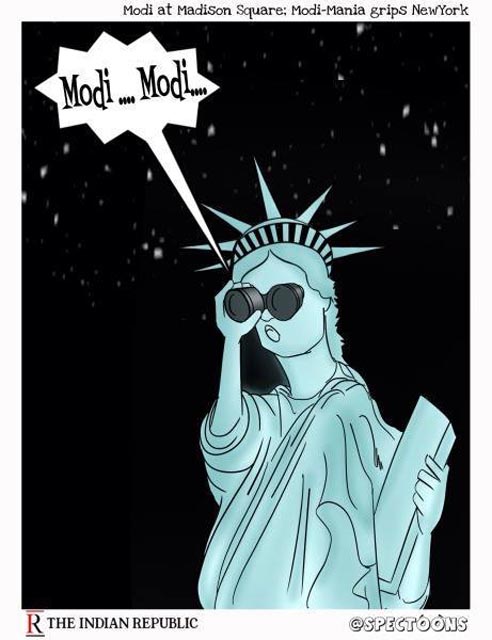
The Modi Juggernaut Comes to America
[dropcap]H[/dropcap]e came, he saw, he conquered.
In popular desi lore, even the name of the venue was transformed from Madison Square Garden to Modison Square Garden. The chants of ‘Mo-Di! Mo-Di!’ were more fevered, more fervent than that for any rock star.
Yes, the rock star of Indian politics is undeniably Prime Minister Narendra Modi, and with his American visit he was on the international world stage. He was in New York and Indian-Americans headed out by the thousands to Madison Square Garden to greet him, to hear him, to just be on the same ground that was beneath his feet.
More a decade ago Modi had been banned in the US for his action – or inaction – in the Godhra killings of 2002, becoming only one of few world leaders to be denied a diplomatic visa to the US. The organizers of that event had to make do with a beamed satellite appearance telecast from India to his followers in Madison Square Garden.
Now that same venue was rocking with the real live man expected there. It was like a visit from God as overjoyed crowds in Modi t-shirts carrying life size cut-outs of the leader were everywhere. Indeed, this MSG gathering is reputed to be the largest public reception for any foreign leader in America, and invitees had flown in from many parts of the Diaspora.
On Facebook, it was a a virtual Modi lovefest; just like any tourist to India must take a photo in front of the Taj Mahal, now everyone – everyone – be it NRIS, their children, society ladies, anyone and everyone wanted to show and prove that they had been invited to the Madison Square Garden reception for Modi. “We were there!”
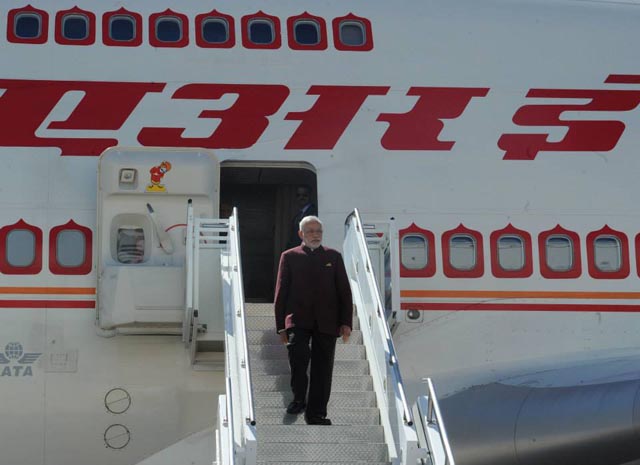
[dropcap]O[/dropcap]rdinary people got a chance to delve into their feelings for the new prime minister on Facebook. As Smita Miki Patel, a noted choreographer whose students did the Garba at the MSG reception wrote on FB: “More pride n honor for me as Mr. Modi is my idol on whom I have been having tremendous faith, trust, respect since 2004 when our school visited Baroda in Gujarat, India on special invitation to perform garba by Gujarat government where we met Mr. Modi, the new iron man of India.”
Photos of Friends and Friends of friends in MSG proliferated in the FB newsfeed, telling a tale of overseas Indians congregating together as never before, with Modi as the unifying glue. Indeed, hard to believe, but 325 organizations had rallied together – Indian organizations usually famous for being all chiefs and no Indians had worked together as a team with clockwork precision.
There was quite a buzz amongst the huge Indian-American community about the Modi visit and. a special website (www.pmvisit.org) had been set up to ensure that everyone gets a ticket to do a Modi darshan at one of the largest public receptions ever organized. In fact, according to IACF President Dr. Bharat Barai , the event had been oversubscribed by 10,000 people and last minute requests to attend came in at the rate of hundreds per day.
Barai said, “To organize such a large program at a venue like the Madison Square Garden in just two-and-a-half months was extremely challenging. Many people discouraged me. I told them that [backing off] was not an option. We had good, dedicated volunteers who gave up a lot to make it work, and work extremely well! It brought out their bright side, and united the community. It was out of love and admiration for Narendrabhai that this could happen.”
[dropcap]B[/dropcap]arai also outlined several innovative features that his team managed to implement despite never having organized an event of this magnitude: web registration, lottery for tickets, live podcast on smartphones, rotating stage at MSG, ending his speech with a shower of balloons, and the live telecast at Times Square. He was also proud of the fact that two food companies distributed 40,000 packages of Indian food to all attendees at the venue as well as in the vicinity.
A special website (www.pmvisit.org) had been set up to ensure hassle free ticket giveaways. The efforts had a handsome payoff, now validated by the record turnout and the precision clockwork of the event. Barai sums up the experience by saying, “The community learnt that we can do great things in a professional way, if we put our thoughts, planning, resources, and soul behind a cause that is dear to most of us. It injected a sense of self-confidence.”
Indeed, the groundwork was done months ahead with visits across the US by Vijay Jolly, Global Convener Overseas Friends of BJP (OFBJP) , and Rajyavardhan Singh Rathore, MP and sports hero, to meet with Indian-Americans, and get everyone involved. Jolly said that they had attended public programs in several US cities in a 12 day visit to thank the Indian-American community for their “catalyst role in shaping the destiny of India in modern times.”
[dropcap]T[/dropcap]he OFBJP organized a pre-visit press conference with chai and pakoras on August 27th at Royal Albert Palace in the heart of Little India in New Jersey, which was followed by a community outreach reception for about 300 people. At the reception, there were many community leaders, supporters and volunteers, and the mood was celebratory. As we stood in line for the dosas, sambar and vadas, I asked Gopi Shah, a young woman who had recently moved from Mumbai to the US as to what excited her about the upcoming visit. She was all smiles as she said, “Ache Din aane wale hain, so I’m waiting to see the person who is bringing in these good days! I really want to see him! The young people are so involved in politics now – that’s the best thing.”
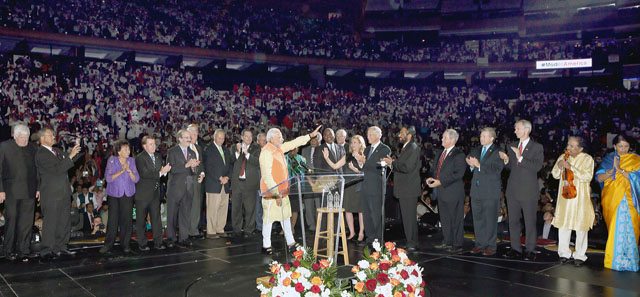
MSG becomes Modison Square Garden
[dropcap]I[/dropcap]ndeed, that sentiment was magnified many times over by thousands more, as to walk the corridors of Madison Square Garden was to see a cheering celebratory Diaspora. It was a full scale Indian invasion of mid-town Manhattan, thanks to Modi. There were Indians, Indians everywhere – in pizza places, in taxis and trains and of course on foot. Indians posing with life-size cutouts of Modi, Indians in Modi shirts being interviewed by the TV channels from India outside Penn Station, Indians with a sudden reason to be celebrating being Indian.
I asked Chandrakant Patel, the president of the OFBJP-USA about the kind of work it took to manage such a large scale event and he said, ” It was definitely the pull of Modi ji’s persona that worked in gathering so many people and so much enthusiasm. He is the most popular leader of the most populous country in the world. About 20 committees and 1500 volunteers worked together in tandem to make this historic program a success, though procedures for pass allocation and distribution should have been better laid out.”
[dropcap]A[/dropcap]sked if his party had any personal interactions with the PM, he said that, “It was always a pleasant experience interacting with him. OFBJP has submitted a memorandum on the issues of Indian Diaspora and some of them were announced by the PM during his MSG address.”
On a personal level, I was curious about Modi’s fast since he was observing the Navratas – did he not eat at all or ate just fruits? We tend to wilt away if we so much as miss a meal – how did he manage to be so remarkably energetic? Said Patel: “He was on warm water with lemon throughout his visit. He has been doing this for the last 36 years. Seems like Yoga power.”
The famous Indian Standard Time, also known as Indian Stretchable Time – was a thing of the past. Indians noted for strolling into shows long after they had begun, were all sitting in their seats long before the PM got there. If in keeping with his cleanliness drive, he had asked each one of them to clean a square foot of Madison Square Garden, they would have willingly done that too!
[dropcap]A[/dropcap]nd what a flawless show it was. Everything followed with clockwork precision – entire families with babies in tow were there for this historic occasion. Even the weather seemed to have been micro-managed – bright beautiful sunshine almost like a summer day in the midst of fall. There seemed such a sense of optimism that India with its 1. 5 billion people, with 50 percent under the age f 25, its energetic, futuristic youth would really take center stage and live up to all its potential.
AT MSG the organizers had skillfully blended India and America in its entertainment with everything from folk dances to popular music to the presence of Kavita Krishnamurthy and violin virtuoso L. Subramaniam. The emcees of the event were 2014 Miss America Nina Davuluri and CNN anchor Hari Sreenivasan, a perfect blend of Indian heritage and American upbringing .
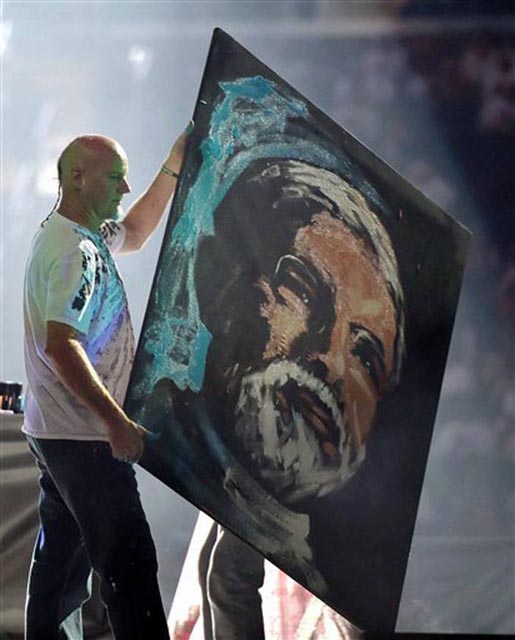
Obama: Khem Cho, Mr. Prime Minister!
[dropcap]T[/dropcap]o the diasporic audience Modi chose to speak in Hindi but later at another event at Central Park with young Americans he chose to speak in English, saying in the language of pop culture “May the Force be with you!” In this global age, communication is key. After all, even President Obama addressed Modi in his native tongue of Gujarati at the entrance of the White House: “Khem Cho, Mr. Prime Minister!”
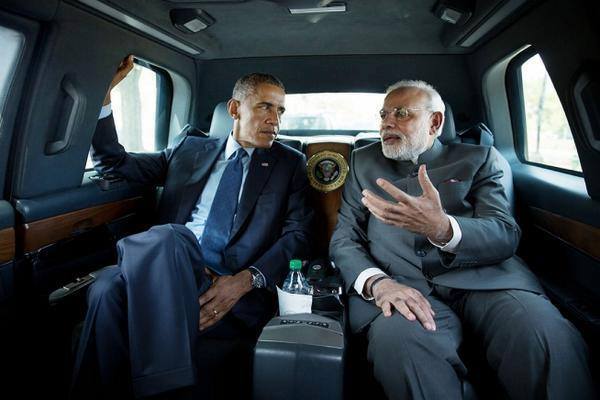
[dropcap]T[/dropcap]he speech at Madison Square Garden was quintessential Modi- with the pm, the chaiwallah and the father of the nation all turned into one. Modi was a Merchant of Dreams, the pitch perfect salesman for India, an energized and motivated and motivational speaker. Indeed, the former chai-seller was there with a much more intoxicating brew of self-sufficiency, of pride, of optimism for India. And Madison Square Garden, renamed by some as Modison Square Garden, was sold out. The Modi fans, the recently converted, and the slightly skeptical were all there.
Here is a translation of his Hindi talk provided on the Modi website:
Shri Narendra Modi said winning the election is a huge responsibility and he will leave no stone unturned to make India a developed country. He said that with the blessings of 125 crore Indians, he was confident that the common man’s hopes and aspirations will be fulfilled. “I will do nothing to make you feel ashamed,” the Prime Minister said. He said that the country now had the capability, the possibility and the opportunity to make the 21st century India’s century. He said India is both the youngest nation and the oldest civilization on earth.
Saying that development is ultimately achieved through public participation, the Prime Minister wants to make development a mass movement, just like Mahatma Gandhi had made the freedom movement a mass movement. He highlighted various initiatives that have been initiated by the new Government including Pradhan Mantri Jan Dhan Yojana, Make in India, Swachh Bharat and Clean Ganga.
[dropcap]A[/dropcap]s Chandrakant Patel, president of OFBJP-USA noted: ” He Stamped a lasting impression on the psyche of the Indian Diaspora, US administration and law-makers, and the world leaders at the United Nations. He brought back the US-India relations on to the track. ”
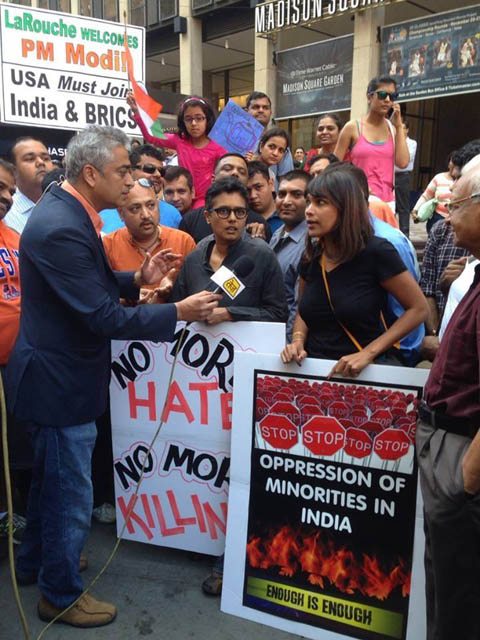
Protestors Raining on the Parade
[dropcap]S[/dropcap]till not everyone was overjoyed with the Modi visit. To walk on the opposite side of Madison Square Garden was to see some police barricades and hear dissenting voices, activists of various stripes who were raining on Modi’s parade. These were activists who chose to be protesting on the streets outside rather than celebrating what they called ‘toxic Hindu nationalism’ inside Madison Square Garden. The four groups were South Asian Solidarity Initiative, Ghadar Alliance, Indian American Muslim Council (IAMC), Sikhs for Justice (SFJ)
As Prachi Patankar, organizer with the South Asian Solidarity Initiative told Khabar: “ We felt that it was our responsibility to voice our opposition to Modi’s hateful agenda, expose his complicity in the past crimes and the whitewashing done by the media and some sections of the diaspora community about his ideology. The U.S. and Indian media has been pushing the rhetoric of ‘let the past go’ and give him time. We had to show that there is not a consensus and many of us don’t support him.”
She said another reason for the protest was to draw attention to current policies which threaten many through the economic agenda, keep pressure in the media and promote a culture of vigilance.
Asked if most Indians would be in tune with that, Patankar responded, “We have to accept that many people will not protest or harshly criticize Modi now but we have to plant the seed so when there are future cultural threats or policies that threaten livelihoods, we have made space for others to join us too.”
[dropcap]W[/dropcap]here there any actual conflicts with the Modi supporters? Patankar said, “There was a very hyper-nationalist, macho celebratory mood in the crowd. Any kind of dissent whether verbally or visually was attacked with abusive language. Many of us had already received threats through online messages on social media and bigoted comments. We were called ‘losers’ to our faces, to which I responded that ‘I would rather be a loser than a fascist'”
She added: “Few individuals, perhaps a small minority of the crowd, of people even going into the event whispered their sympathy said that it was important that we were here to hold him accountable to keep some pressure on him and expressed embarrassment at the majority of hyper-nationalist and bigoted crowd. We want to start with building a campaign in the Diaspora to change the narrative around Modi.”
Maya Chadda, professor of International Relations at William Paterson University of NJ, is an insightful India watcher for several decades. She had a view to share about the amnesia about Gujarat in view of the Indo-US relations.
” I think that the Gujarat episode is like a silt that settles to the bottom only to rise when the waters are roiled,” she said. “My India watchers among American politicians and scholars here worry about the rise of bhagwats and all the parivar organization at grass roots level and the incorporation of Jan Sanghis in ministries and party leadership but they are willing to do business piece – by – piece. This signals lack of trust and caution. That will not take us far. Both countries need to decide that each can sacrifice their immediate interests or compromise them to an extent for longer stronger relationship. The 2002 will resurface until Modi manages to build this relationship to a level where it is erased by goodwill.”
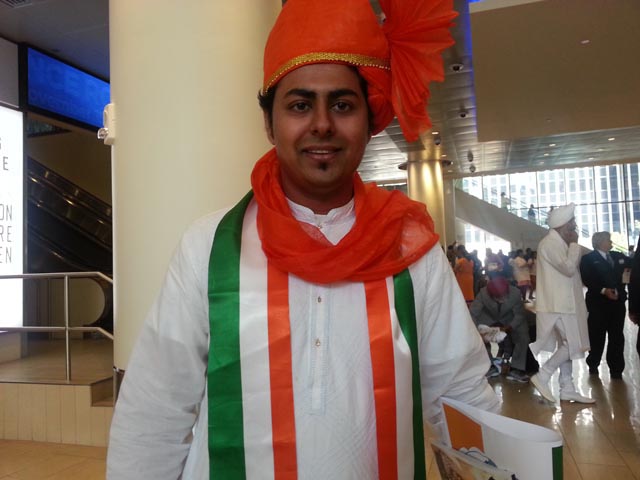
The Modi Mantras
[dropcap]T[/dropcap]his may be so but the words which seemed to resonate with the Diaspora Indians gathered in MSG were the Modi Mantras about India’s place in the world, the grand promise of the 21st century being India’s Century. After all, Indians had just made it to Mars that week – and on a smart budget that could not be matched by the West! Modi spoke passionately of development as a mass movement and the right of every Indian to have a home and an income, and the hall erupted with joy, claps and cascades of balloons in the colors of the two countries.
By and large, Indian immigrants and second generation Indian-Americans have the welfare of India at heart and want it to succeed – and succeed phenomenally. Their self-esteem and self-worth is tied up with that of India. Without a doubt, the Modi interaction with the Indian Diaspora was a tremendous box-office hit, the equivalent of a Bollywood bonanza.
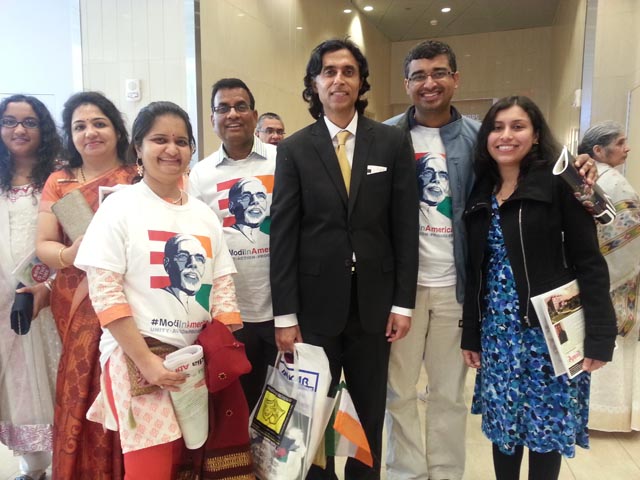
[dropcap]A[/dropcap]s far as the interaction with the larger America goes, Modi seems to have scored very well too with American political and business leaders joining the ever-burgeoning fan club. There has been so much written about the Modi Visit that one could create a chunky Modi Chronicle from it – different opinions depending on the bent of the writer or the publication.
Wrote Times of India: ” The scorching pace of 35 meetings set by the fasting PM showed very clearly that Modi went to the US with a clear strategy, one that would stretch well beyond the visit. Unlike both Vajpayee and Manmohan Singh, Modi went to the US with a strong domestic agenda. Modi’s aim was to converge his domestic priorities with his foreign policy, which explains why the joint statement bears such a strong stamp of the prime minister himself. Modi put his shoulder to the wheel to turn India’s US policy to align itself to India’s domestic transformation and its global aspirations. In many ways, that is his greatest success.”
Perception counts for a lot and for Indians – both at home and abroad – the Modi visit to the US was a shining moment, one they will talk about to their children and grandchildren. For immigrants who have struggled and worked hard for decades, this was a dream come true when a common desi chaiwalla from humble beginnings crystallized their aspirations in America.
The chaiwalla was surrounded by 20,000 people and he was not selling chai anymore. He was selling national and global dreams, possibilities, ideas, ideals – and he had a captive audience of hundreds of thousands via live casts in Time Square and globally, and many more through social media.
Indians worldwide always love a doer, a karmachari, a can-do rainmaker. And Modi was their man. It was a coronation – no doubt about it.
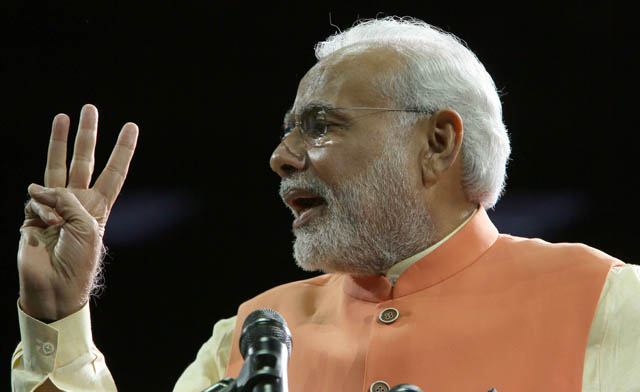
Maya Chadda: Deciphering the Impact of Modi’s Yatra
We asked Dr. Maya Chadda, who is member of the Foreign Relations Committee, for her take on the impact the Modi visit had on Indo-US relations. Chadda is author of several books on South Asia and regional politics, including the current critically acclaimed book: “Why India Matters”
“It was essentially a stock taking meeting to consolidate mutual intentions to move the relationship forward, gauging of leadership and personalities on both sides and the level of commitment and strength to carry agreements forward. Obama was cautiously impressed is my take,” she said.
So did Modi achieve what was expected? The answer is probably yes, but largely in atmospherics and specifying desire for restoring the lost momentum but now comes the hard in sorting it all out. In this, domestic opposition to specific changes he needs to make – nuclear liability law for instance- will slow it down.
She believes that the Obama Administration had determined ahead of the visit that the ties had to be revived: “Modi has been playing more coy because there is a alternate school of thought among the Sangh/ BJP thinkers that India might be better off by not too closely tying up with the US, instead India should, they argue, keep options open by building on close cooperative relationship with Japan and China separately and inserting this its growing network of ties to Southeast Asia and beyond. ”
She added, ” In other words, India will not quickly fall into a position of a junior partner in the TPP (Transpacific partnership) and the security architecture US is developing in Asia-Pacific ( re balancing or pivot to Asia) but retain instead a degree of independence, sort of Non-alignment 2.”
She believes that Modi’s vision has a strong economic component and therefore the US is important but when it comes to security cooperation, Modi is none too sure how far to depend on the US in protecting Indian interests: ” Currently, the region of Asia-Pacific and India’s position in it is all in flux, the new leaders in Delhi are in the process of figuring it out. The course is not set as yet. What is set is to reviving the economy. The biggest stumbling block on this with the US is conflict over trade issues.
Not sufficient attention is paid to this because these are not sexy like the ones on security but trade is crucial in furthering Indo-US ties. There are large differences in approach and priorities between the US and India on this. The areas of convergence are pock marked by areas of unbridgeable differences. Nuclear liability and subsidies to farmers and food security legislation that just passed by our parliament are chief among the obstacles preventing momentum to indo-US ties.”
She observes, “The members of the Council on Foreign were impressed by the projection of Modi persona, his confidence and ease, his sense of representing a great nation and his rhetorical flourishes. But most regretted that the speech lacked substance. We in the CFR are used to getting some sense of where the foreign policy is headed. Mr. Modi gave the same speech he gave in Madison Square garden to an over-enthused home audience. This was highly disappointing to most and in fact Richard Hass ended the meeting with a cryptic comment, ‘There is one thing we have learnt from you Mr. PM, how not to answer questions, the art of evasion.’ Mr. Modi smiled. But most in the audience got the sense that the speech was meaningless for the most part. Not the Indian members who are very few but the rest.
We came and saw the anointed king but got no directions from him, nor any inkling as to how India will maneuver through many contradictions it will face. How for example will Modi find a way through the Japan China animosity when India wants to be a friend of both or the Iran issue and US objections, or of course Pakistan and the US ambivalence about how to deal with the triad of India, Pakistan and China at the meeting points of troubled borders and relations. Mr. Modi is a great campaigner and grassroot pracharak but a unproven leader in the global corridors of power.”
This article was first published in Khabar magazine
Related Article:

3 Comments
Modi is being a global leader
Via Google +
vishnu patidar and Neerav Trivedi
+1’d: http://bit.ly/1D4XMSj
Via Google +
Ashwin Kr and Meenu Dubey
+1’d: http://bit.ly/1D4XMSj